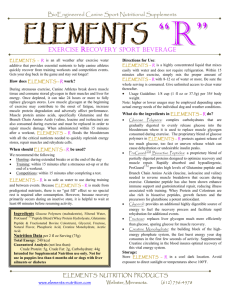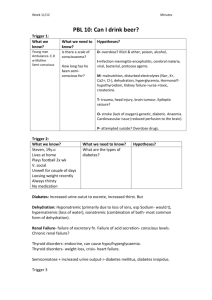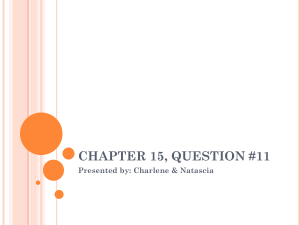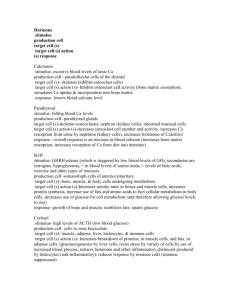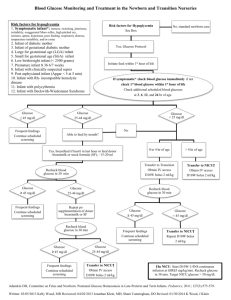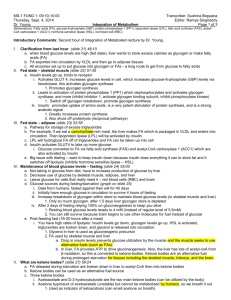Protein-Energy Malnutrition: Objectives
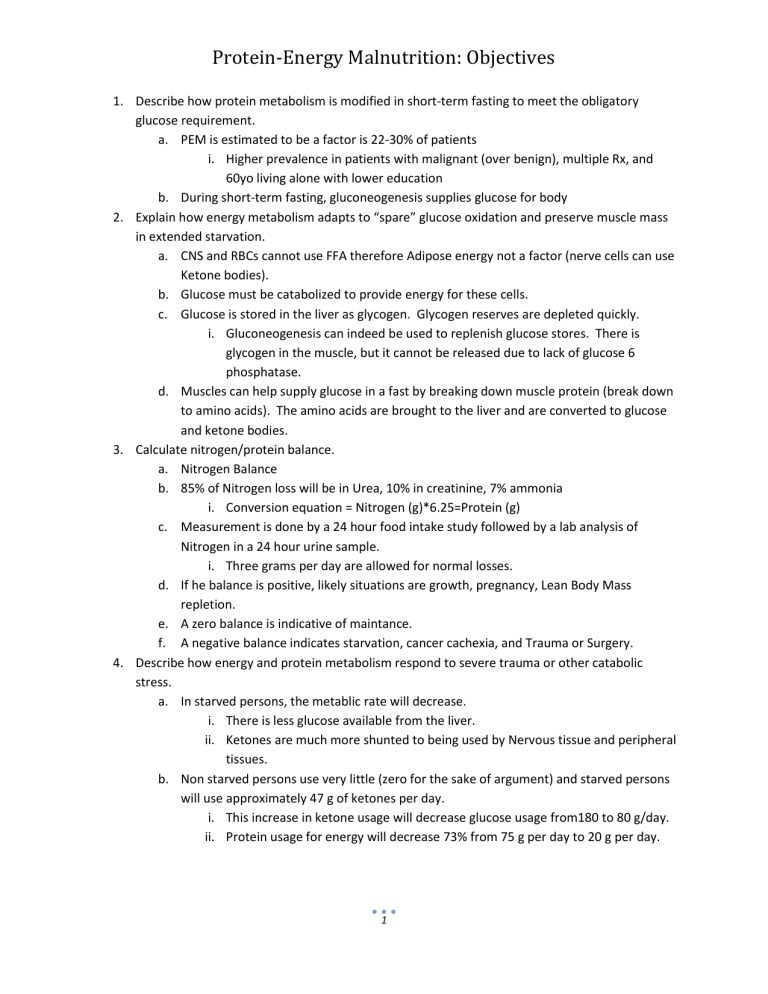
Protein-Energy Malnutrition: Objectives
1.
Describe how protein metabolism is modified in short-term fasting to meet the obligatory glucose requirement. a.
PEM is estimated to be a factor is 22-30% of patients i.
Higher prevalence in patients with malignant (over benign), multiple Rx, and
60yo living alone with lower education b.
During short-term fasting, gluconeogenesis supplies glucose for body
2.
Explain how energy metabolism adapts to “spare” glucose oxidation and preserve muscle mass in extended starvation. a.
CNS and RBCs cannot use FFA therefore Adipose energy not a factor (nerve cells can use
Ketone bodies). b.
Glucose must be catabolized to provide energy for these cells. c.
Glucose is stored in the liver as glycogen. Glycogen reserves are depleted quickly. i.
Gluconeogenesis can indeed be used to replenish glucose stores. There is glycogen in the muscle, but it cannot be released due to lack of glucose 6 phosphatase. d.
Muscles can help supply glucose in a fast by breaking down muscle protein (break down to amino acids). The amino acids are brought to the liver and are converted to glucose and ketone bodies.
3.
Calculate nitrogen/protein balance. a.
Nitrogen Balance b.
85% of Nitrogen loss will be in Urea, 10% in creatinine, 7% ammonia i.
Conversion equation = Nitrogen (g)*6.25=Protein (g) c.
Measurement is done by a 24 hour food intake study followed by a lab analysis of
Nitrogen in a 24 hour urine sample. i.
Three grams per day are allowed for normal losses. d.
If he balance is positive, likely situations are growth, pregnancy, Lean Body Mass repletion. e.
A zero balance is indicative of maintance. f.
A negative balance indicates starvation, cancer cachexia, and Trauma or Surgery.
4.
Describe how energy and protein metabolism respond to severe trauma or other catabolic stress. a.
In starved persons, the metablic rate will decrease. i.
There is less glucose available from the liver. ii.
Ketones are much more shunted to being used by Nervous tissue and peripheral tissues. b.
Non starved persons use very little (zero for the sake of argument) and starved persons will use approximately 47 g of ketones per day. i.
This increase in ketone usage will decrease glucose usage from180 to 80 g/day. ii.
Protein usage for energy will decrease 73% from 75 g per day to 20 g per day.
1
Protein-Energy Malnutrition: Objectives
5.
Differentiate between protein-energy malnutrition (PEM) induced by starvation from that induced by acute trauma in their clinical presentation and diagnosis. a.
Marasmus is a type of PEM. i.
It is gradual onset (weeks to months of inadequate food intake). ii.
Involuntary loss of 10-15% is a huge indicator. iii.
Muscle wasting is only evident after months. b.
Acute Catabolic Insult-Induced PEM. i.
Is commonly caused by Major Trauma or severe infection. ii.
The catabolic phase is 3-10 days long and is directly related to the degree of injury. iii.
The response is not limited to the site of injury and is systemic. iv.
Hormonally, ACTH (cortisol), glucacon increase and insulin sensitivity decreases.
1.
These changess induce a hypermetabolic state (BMR is increased). v.
Gluconeogenisis will accelerate and glucose utilization at the site of injury will increase. vi.
At the peripheral tissues, glucose utilization will decrease. vii.
They will look normal (not emaciated). viii.
There is a LARGE negative nitrogen balance. ix.
In Acute PEM, albumin and other blood proteins will decrease within 4-10 days.
1.
Muscle protein metabolism will increase moderately, but muscle wasting will not be evident for quite some time.
6.
Estimate energy and protein requirements to recover from REM. a.
20-30kcal/kg of body weight i.
Can directly measure energy requirements by O2 utilization for severely injured patients b.
Overfeeding inhibits recovery from PEM i.
Electrolytes mess up
7.
List the routes of nutrient hyperalimentation and the advantages/disadvantages of each route. a.
Oral intake i.
Example: “Ensure” b.
Enteral Tube Feedings i.
Relatively inexpensive, nutrient influx is regulated by enterohepatic system c.
Parenteral Feedings i.
Directly into the bloodstream ii.
Lack of “first pass” liver monitoring iii.
Short term use only d.
IV tube feedings into central veins i.
Relatively expensive ii.
Can be used long term
2


